“Woman in Full Dress by Solvyns” has been added to your cart.
View cart
-
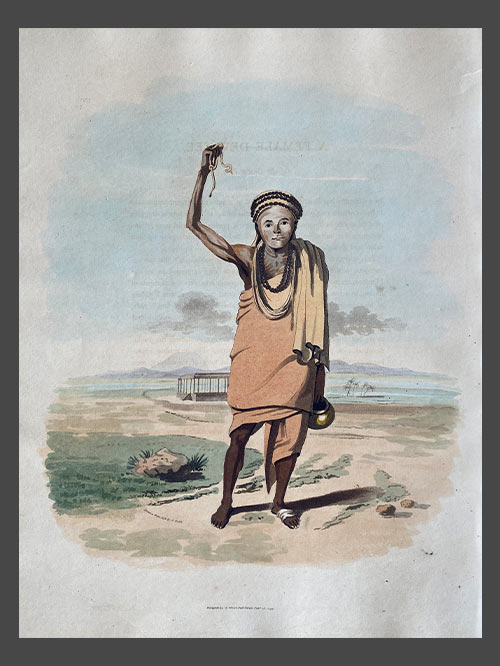
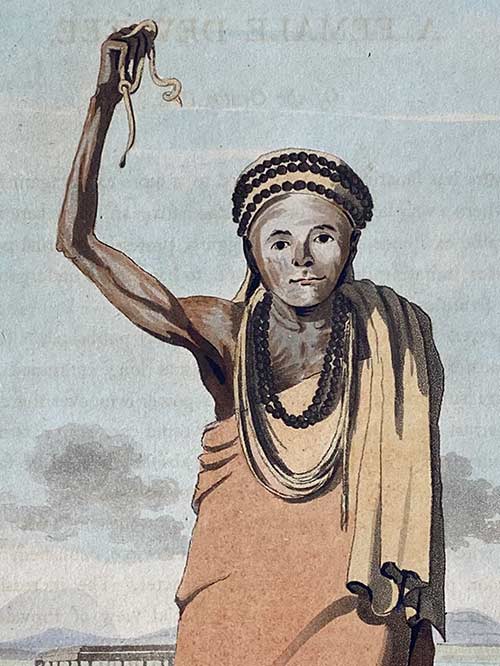
Pub. London
original hand-coloured aquatint
Captain Charles Gold (d. 1842) served in the military campaigns against Tipu Sultan, the ruler of the Kingdom of Mysore and during 1791-98 he sketched a series of images later published as aquatints in “Oriental Drawings.” He was fascinated with the concept of religious begging and documented all manners of mendicants and zealots that he met on his travel, often detailing their unique trials and tribulations.While these prints cannot be divorced from the orientalist roots from which they came, they are a compelling visual memoir of a time and people that may have otherwise been lost to time.
The devotee drawn by the artist, “made a vow, in order to gain favour with the gods, to keep her right arm uplifted, and let the finger nails of that hand grow for twelve years. The cord worn round her neck she used for the purpose of tying up her arm at night when going to rest. Her hand being nearly closed, the thumb nail arched directly over it, the fore finger nail assumed a spiral or cork-screw form, that of the middle took an extraordinary direction, encircling the little finger nail, which grew more regularly than the others, and descended about half way to her elbow, the remaining or fourth nail being broken off half an inch from the finger end. She had adopted the orange coloured dress usually worn by the religious orders in India; and being subsisted entirely by the liberality of the devout, who regarded her as a saint, travelled the country with a brass pot, to receive their pious donations in. Her face, right arm, and neck, were smeared over with a white powder. The ornaments round her head and neck are seeds of a fruit which grows in the north of India, called the nut of Rouderin. The cloth round her right foot was merely to cover a hurt received in travelling, as she did not indulge with shoes. In the distance is a Choultry, built at the expence of some charitable Gentoo, for the accommodation of travellers.”
Size (cms): 33(H) x 25(W)
Size (inches): 13(H) x 10(W)
-
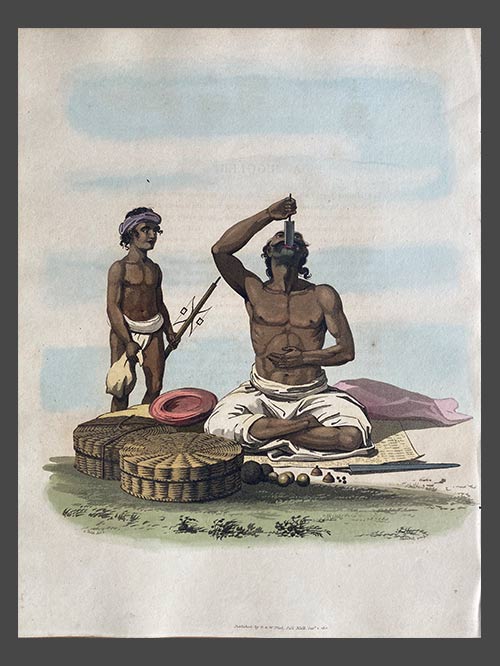
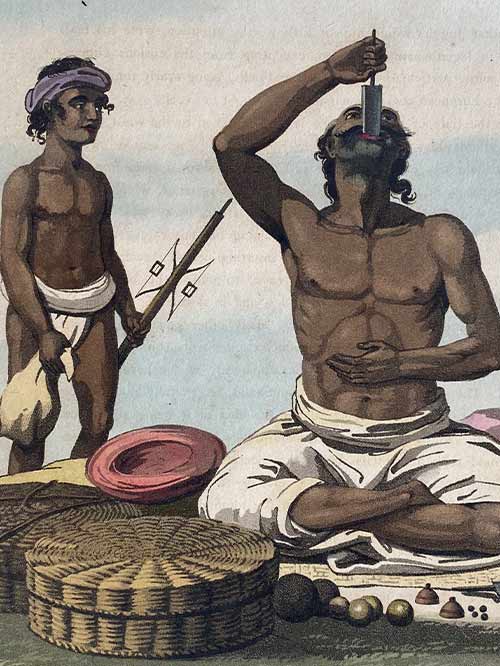
Pub. London
original hand-coloured aquatint
Captain Charles Gold (d. 1842) served in the military campaigns against Tipu Sultan, the ruler of the Kingdom of Mysore and during 1791-98 he sketched a series of images later published as aquatints in “Oriental Drawings.” He was fascinated with the concept of religious begging and documented all manners of mendicants and zealots that he met on his travel, often detailing their unique trials and tribulations.While these prints cannot be divorced from the orientalist roots from which they came, they are a compelling visual memoir of a time and people that may have otherwise been lost to time.
Fascinated by his encounter, the artist recounts “the Juggler in the usual attitude of putting the sword-blade down his throat; is seated on a mat, with his cups and balls before him; also two heavy stone balls, which he throws alternately to a great height, and catches on his bare back. The baskets contain his various apparatus, and the little fellow, his son and apprentice, holds a small whirling instrument, which he balances and plays various tricks with. His dress and turban lay on the ground behind. The most surprising of his performances, which consist of various distortions of his person, is to raise by the strength of his eyelids, two baskets containing his apparatus, being of several pounds weight. That which excites wonder in the greatest degree is the swallowing a sword blade, apparently at the hazard of his existence. The practicability of this experiment, is generally doubted by those who have not witnessed it; under the idea of it being performed with a spring sword. He swallowed to the very hilt the blade of a broad-sword, blunted in the edges and point, and about eighteen inches long, which I absolutely felt in his stomach. As may be supposed, the exertion and straining affects the poor fellow a good deal at the time, but a glass or two of arrack or brandy which he never fails to ask for, soon refreshes him.”
Size (cms): 33(H) x 25(W)
Size (inches): 13(H) x 10(W)
-
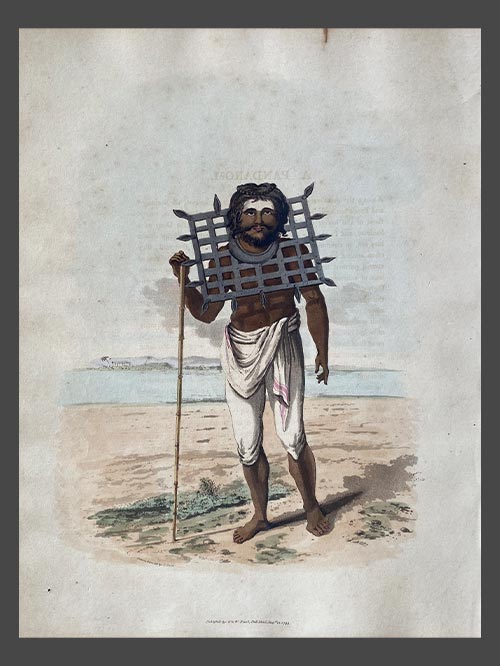
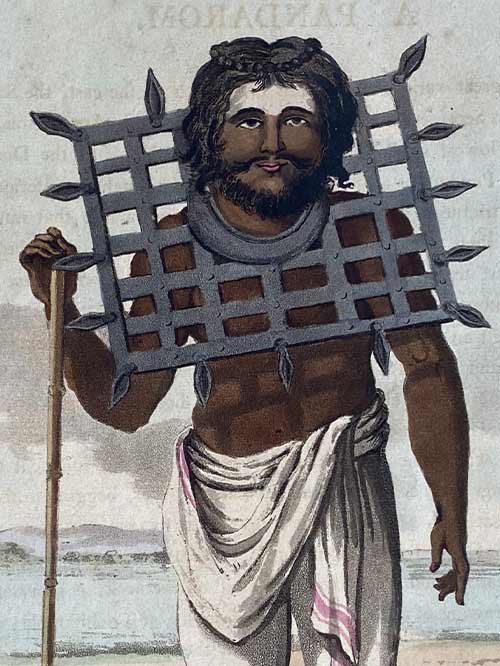
Pub. London
original hand-coloured aquatint
Captain Charles Gold (d. 1842) served in the military campaigns against Tipu Sultan, the ruler of the Kingdom of Mysore and during 1791-98 he sketched a series of images later published as aquatints in “Oriental Drawings.” He was fascinated with the concept of religious begging and documented all manners of mendicants and zealots that he met on his travel, often detailing their unique trials and tribulations.While these prints cannot be divorced from the orientalist roots from which they came, they are a compelling visual memoir of a time and people that may have otherwise been lost to time.
The artist describes his interaction with the mendicant he drew “from life at Trichinopoly; whither he had travelled to attend a grand festival at the celebrated Pagoda on the isle of Seringham. The grate he wore was encompassed by sixteen small lamps, which on particular occasions he caused to be illuminated. He usually wore his grate in an horizontal position, as it then rested on his shoulders with more ease. His forehead was whitened with cow-dung ashes, and his head ornamented with a circular string of the nuts of Rouderin. Among the great variety of religious enthusiasts in the east, the Saniassy and Pandarom Sects are held in the highest veneration. Under the vow of eternal poverty, temperance, and chastity, these people, with every appearance of contentment, lead a wandering and precarious existence, being entirely dependent on alms. There are instances of some, who have vowed never more to speak, others form a resolution to continue in an upright posture, without ever lying down; and to prevent the possibility of sleeping in comfort, wear an iron grate, closely rivetted on the neck,” as represented in this hand-coloured aquatint.
Size (cms): 33(H) x 25(W)
Size (inches): 13(H) x 10(W)
-
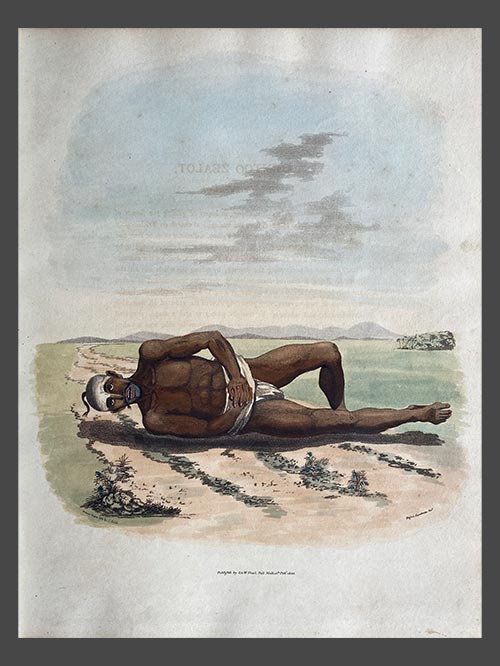
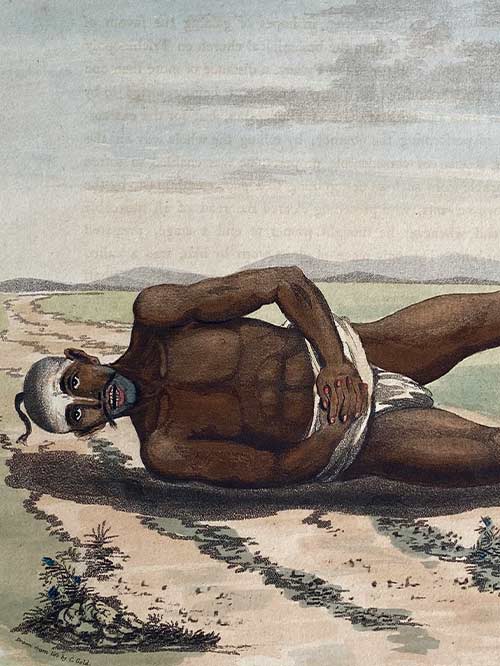
Pub. London
original hand-coloured aquatint
Captain Charles Gold (d. 1842) served in the military campaigns against Tipu Sultan, the ruler of the Kingdom of Mysore and during 1791-98 he sketched a series of images later published as aquatints in “Oriental Drawings.” He was fascinated with the concept of religious begging and documented all manners of mendicants and zealots that he met on his travel, often detailing their unique trials and tribulations.While these prints cannot be divorced from the orientalist roots from which they came, they are a compelling visual memoir of a time and people that may have otherwise been lost to time.
The artist remarked on his encounter with this “Gentoo Zealot,” who was “rolling through the fort of Trichinopoly, in the exact posture this drawing represents, and singing, or rather crying aloud, the praises of his God. The person represented in this drawing, in hopes of gaining the favour of his God, had resolved to travel from the brahminical church on Trichinopoly rock, to the famous temple on the hill of Pylney, a distance of more than one hundred miles, performing the journey, by rolling the whole way on the ground. Being a man of considerable property, he was enabled to soften the toils inseparable from such an undertaking, by the attentions of two servants, who preceding cleared the road of all moreable impediments, and whenever he thought proper to end a stage, prepared refreshments for him. The only piece of dress worn by him, was a calico cloth wrapped about the waist ; his hair was close shaved excepting a small lock on the back part of the crown, and his head entirely exposed to the influence of the sun and reflected heat from the ground, which it nearly touched every revolution he made.”
Size (cms): 33(H) x 25(W)
Size (inches): 13(H) x 10(W)
-
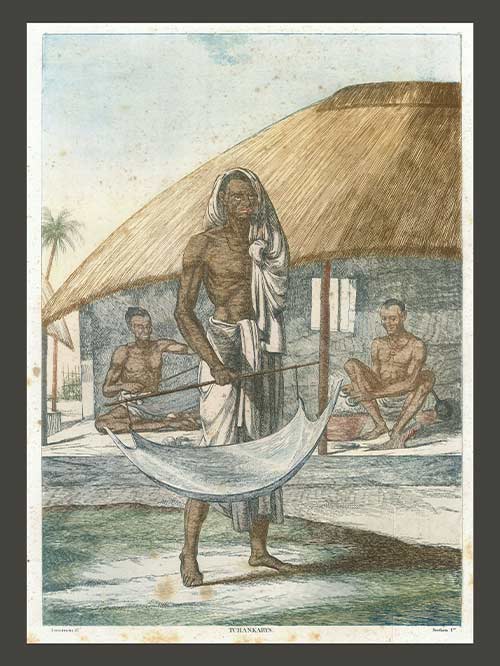

by Francois-Balthazar Solvyns (1760-1824)
Original coloured etching
from Les Hindous
Pub. Paris
Solvyns’ portrayal of a craftsman wielding the distinctive sankha-karat saw, encapsulates the specialised craftsmanship of the Sakhari caste of conch shell bangles cutters in Calcutta. Occupying their own neighborhood, or tola, within the city, Sakhari artisans use the three-foot-long crescent-shaped saw to intricately cut and shape conch shells. Utilising an iron saw without teeth, akin to those used for marble, the craftsman achieves precise cuts through sustained friction, anchoring the shell between his feet for stability, as depicted in the background. Following cutting, the shells undergo refinement through rubbing against a hard stone with sand and water to ensure smooth surfaces. Subsequently, the rings are meticulously adjusted, adorned with red gum or wax to conceal joints, and polished or engraved as required, culminating in the creation of finished bangles. These red conch shell bangles symbolise marriage for Bengali women of “respectable castes,” akin to the red streak in their hair part, and are preferred over glass and metal alternatives.
Frans Balthazar Solvyns, was a skilled engraver and painter hailing from Antwerp, embarked on a transformative journey to India in 1790. Settling in Calcutta, Solvyns immersed himself in the intricacies of Indian life, studying Hindi and forging relationships with Brahmins and pundits. Inspired by his surroundings, he commenced his ambitious project in 1791, aiming to depict the diverse facets of Indian society, from occupations to customs which he published in a series of engravings. Despite its sensitive portrayal, the venture encountered little success initially, prompting Solvyns’ departure from India in 1803. However, his legacy endured through subsequent publications, notably “The Costume of Hindoostan” and the expanded edition of “Les Hindous,” offering an intimate and detailed glimpse into 18th-century Indian life across professions, festivals, and daily rituals, immortalising a unique historical moment with both reverence and curiosity.
Image Size (cms): 35(H) x 24(W)
Image Size (inches): 14(H) x 9.5(W)
Mount Size (cms): 51(H) x 41(W)
Mount Size (inches): 20(H) x 16(W)
-
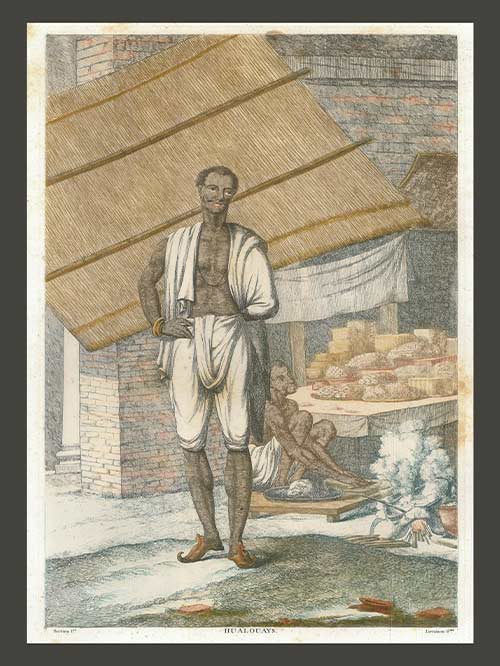

by Francois-Balthazar Solvyns (1760-1824)
Original coloured etching
from Les Hindous
Pub. Paris
Halwais confectioners, specialise in making a variety of sweets using a flour base, distinctive to North India, unlike the milk and sugar-based Bengali sweets prepared by Mayaras. Their name derives from “halwa,” a sweet made of flour, ghee, sugar, and often flavoured with cardamom and almonds, sometimes coloured with saffron and mixed with raisins or pistachio nuts. The confections are prepared through various methods, such as frying flour in ghee, boiling it in milk and sugar, or baking in earthen pans. Puddings, including those with grated vegetables like carrots, are popular, while delicate varieties use cream, demanding skill in preparation. Despite the Arabic origin of the term “halwa,” Halwais are Hindu Sudras, not Muslims, and they play a significant role in Hindu festivities and ceremonies, supplying sweetmeats for various occasions.
Frans Balthazar Solvyns, was a skilled engraver and painter hailing from Antwerp, embarked on a transformative journey to India in 1790. Settling in Calcutta, Solvyns immersed himself in the intricacies of Indian life, studying Hindi and forging relationships with Brahmins and pundits. Inspired by his surroundings, he commenced his ambitious project in 1791, aiming to depict the diverse facets of Indian society, from occupations to customs which he published in a series of engravings. Despite its sensitive portrayal, the venture encountered little success initially, prompting Solvyns’ departure from India in 1803. However, his legacy endured through subsequent publications, notably “The Costume of Hindoostan” and the expanded edition of “Les Hindous,” offering an intimate and detailed glimpse into 18th-century Indian life across professions, festivals, and daily rituals, immortalising a unique historical moment with both reverence and curiosity.
Image Size (cms): 35(H) x 24(W)
Image Size (inches): 14(H) x 9.5(W)
Mount Size (cms): 51(H) x 41(W)
Mount Size (inches): 20(H) x 16(W)
-

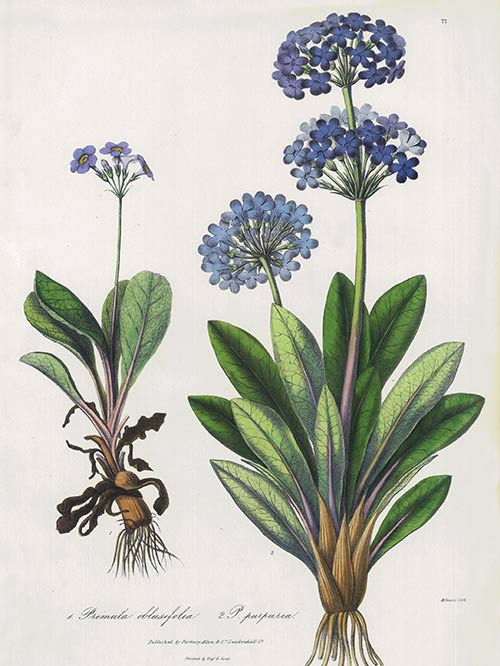
by John Forbes Royle (1798-1858)
Original hand-coloured lithograph
Pub. London
This decorative botanical lithograph depicts two flowering plants, the Primula obtusifolia, commonly known as “Blunt-leaved Primrose,” and the Primula purpurea, commonly known as Purple Himalayan Primrose.” Both are native to the Himalayan region, particularly found in parts of India, Nepal, Bhutan, and Tibet. They grow in alpine meadows and rocky slopes, thriving in cooler, mountainous climates. It is often cultivated as an ornamental plant for its charming flowers and attractive foliage.
John Forbes Royle was a prominent British botanist, physician, and pharmacologist during the 19th century. Royle received his medical education at St. Thomas’s Hospital in London and later served as a surgeon in the British East India Company’s army. During his time in India, Royle became deeply interested in the country’s flora and medicinal plants. He collected a vast number of plant specimens and meticulously documented their medicinal properties. One of Royle’s most notable works was the ‘‘Illustrations of the botany and other branches of the natural history of the Himalayan Mountains and of the flora of Cashmere’. This comprehensive work provided detailed descriptions and illustrations of numerous plant species found in the Himalayan region. It remains an important reference for botanical research in the area.
Image Size (cms): 36.5(H) x 26(W)
Image Size (inches): 14.5(H) x 10(W)
Mount Size (cms): 51(H) x 41(W)
Mount Size (inches): 20(H) x 16(W)
-

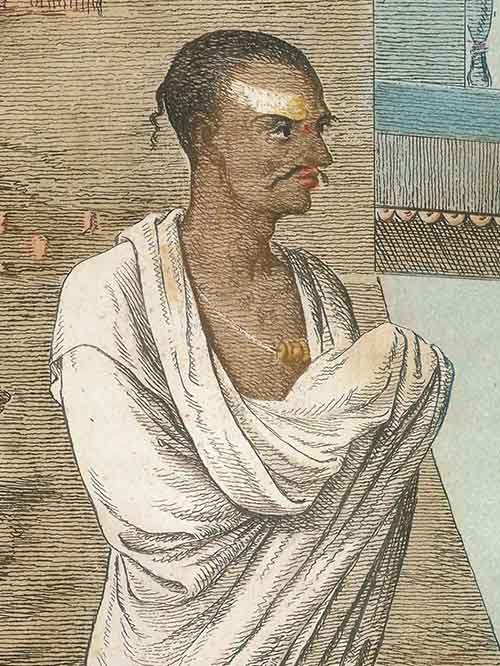
by Francois-Balthazar Solvyns (1760-1824)
Original coloured etching
from Les Hindous
Pub. Paris
Frans Balthazar Solvyns, was a skilled engraver and painter hailing from Antwerp, embarked on a transformative journey to India in 1790. Settling in Calcutta, Solvyns immersed himself in the intricacies of Indian life, studying Hindi and forging relationships with Brahmins and pundits. Inspired by his surroundings, he commenced his ambitious project in 1791, aiming to depict the diverse facets of Indian society, from occupations to customs which he published in a series of engravings. Despite its sensitive portrayal, the venture encountered little success initially, prompting Solvyns’ departure from India in 1803. However, his legacy endured through subsequent publications, notably “The Costume of Hindoostan” and the expanded edition of “Les Hindous,” offering an intimate and detailed glimpse into 18th-century Indian life across professions, festivals, and daily rituals, immortalising a unique historical moment with both reverence and curiosity.
Image Size (cms): 35(H) x 24(W)
Image Size (inches): 14(H) x 9.5(W)
Mount Size (cms): 51(H) x 41(W)
Mount Size (inches): 20(H) x 16(W)
-
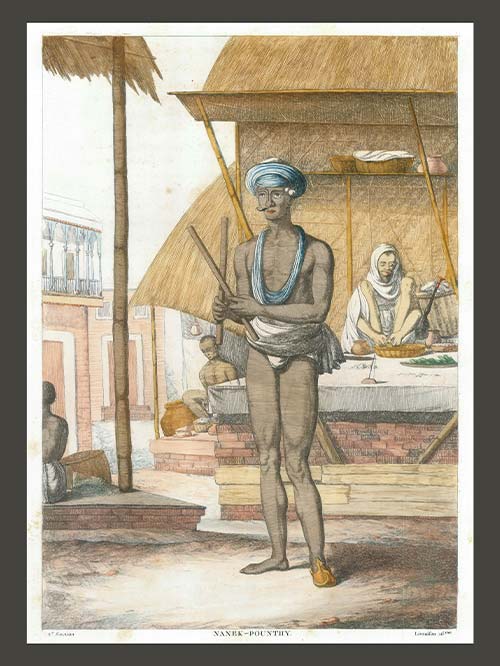

by Francois-Balthazar Solvyns (1760-1824)
Original coloured etching
from Les Hindous
Pub. Paris
Solvyns describes the Nanuk-Punthys as a unique and relatively peaceful group of Faquirs, distinguished by their peculiar appearance, including wearing only half a moustache and one shoe. They adorn their turbans with silver bells, and carry sticks which they continuously strike together while reciting prayers and legends with remarkable speed. Some Nanuk-Punthys roam markets and public places, while others visit houses and shops, engaging in perpetual harangues. Despite their eccentricities, they are generally treated with respect, particularly among Sikhs and Marathas. Solvyns’ portrayal of the Nanuk-Punthys presents a puzzling depiction that doesn’t neatly align with known religious sects or orders of the time. While the term “Nanak Panthi” typically refers to followers of Guru Nanak, the lack of clear identification in Solvyns’ description leaves scholars and historians uncertain about their exact classification within the religious landscape of the period.
Frans Balthazar Solvyns, was a skilled engraver and painter hailing from Antwerp, embarked on a transformative journey to India in 1790. Settling in Calcutta, Solvyns immersed himself in the intricacies of Indian life, studying Hindi and forging relationships with Brahmins and pundits. Inspired by his surroundings, he commenced his ambitious project in 1791, aiming to depict the diverse facets of Indian society, from occupations to customs which he published in a series of engravings. Despite its sensitive portrayal, the venture encountered little success initially, prompting Solvyns’ departure from India in 1803. However, his legacy endured through subsequent publications, notably “The Costume of Hindoostan” and the expanded edition of “Les Hindous,” offering an intimate and detailed glimpse into 18th-century Indian life across professions, festivals, and daily rituals, immortalising a unique historical moment with both reverence and curiosity.
Image Size (cms): 35(H) x 24(W)
Image Size (inches): 14(H) x 9.5(W)
Mount Size (cms): 51(H) x 41(W)
Mount Size (inches): 20(H) x 16(W)
-


by John Forbes Royle (1798-1858)
Original hand-coloured lithograph
Pub. London
Nardostachys jatamansi, commonly known as “Spikenard” or “Jatamansi,” is a flowering plant in the Valerianaceae family. It is native to the Himalayan region, particularly found in parts of India, Nepal, Bhutan, and Tibet. This perennial herbaceous plant is characterized by its long, slender rhizomes and clusters of small, pink flowers. Spikenard has a long history of traditional medicinal use in Ayurvedic and Tibetan medicine, where it is valued for its calming and sedative properties. It is also used in perfumery and aromatherapy for its unique and earthy fragrance.
John Forbes Royle was a prominent British botanist, physician, and pharmacologist during the 19th century. Royle received his medical education at St. Thomas’s Hospital in London and later served as a surgeon in the British East India Company’s army. During his time in India, Royle became deeply interested in the country’s flora and medicinal plants. He collected a vast number of plant specimens and meticulously documented their medicinal properties. One of Royle’s most notable works was the ‘‘Illustrations of the botany and other branches of the natural history of the Himalayan Mountains and of the flora of Cashmere’. This comprehensive work provided detailed descriptions and illustrations of numerous plant species found in the Himalayan region. It remains an important reference for botanical research in the area.
Image Size (cms): 36.5(H) x 26(W)
Image Size (inches): 14.5(H) x 10(W)
Mount Size (cms): 51(H) x 41(W)
Mount Size (inches): 20(H) x 16(W)
-
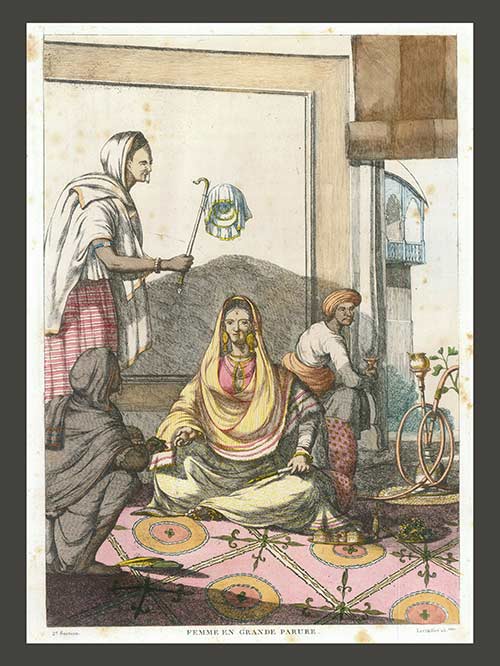

by Francois-Balthazar Solvyns (1760-1824)
Original coloured etching
from Les Hindous
Pub. Paris
Solvyns provides a vivid portrayal of a wealthy Hindu woman in full dress, emphasising both the magnificence of her attire and the richness of her surroundings. The woman is seated on a luxurious carpet, with her legs and arms supported by embroidered silk cushions. She is attended by two ayahs (maid servants). One maid offers her paan while another fans her with a hand pankh to refresh the air around her face. In the background, a hookah-bearer prepares the hookah for her to smoke. The lady’s appearance is meticulously described: her hair, made shiny with cocoa oil, is plaited and adorned with pearls or precious stones, with the largest gem positioned in the middle. Solvyns highlights her isolation and idle life, noting that women of her rank live in seclusion, removed from both labor and society, their lives marked by a lack of purpose and contribution, engaging in minimal activities such as playing the tom-tom.
Frans Balthazar Solvyns, was a skilled engraver and painter hailing from Antwerp, embarked on a transformative journey to India in 1790. Settling in Calcutta, Solvyns immersed himself in the intricacies of Indian life, studying Hindi and forging relationships with Brahmins and pundits. Inspired by his surroundings, he commenced his ambitious project in 1791, aiming to depict the diverse facets of Indian society, from occupations to customs which he published in a series of engravings. Despite its sensitive portrayal, the venture encountered little success initially, prompting Solvyns’ departure from India in 1803. However, his legacy endured through subsequent publications, notably “The Costume of Hindoostan” and the expanded edition of “Les Hindous,” offering an intimate and detailed glimpse into 18th-century Indian life across professions, festivals, and daily rituals, immortalising a unique historical moment with both reverence and curiosity.
Image Size (cms): 35(H) x 24(W)
Image Size (inches): 14(H) x 9.5(W)
Mount Size (cms): 51(H) x 41(W)
Mount Size (inches): 20(H) x 16(W)























